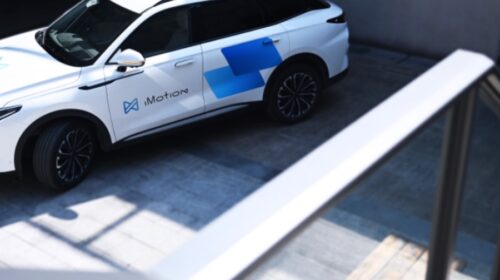iMotion stuck with low margins as future hinges on self-developed systems

The autonomous driving company’s revenue grew significantly in the first half of the year, while its gross margins remain meager
Key Takeaways:
- iMotion generated 640 million yuan in revenue in the first half of the year, up 17.1%, as its loss narrowed slightly to 98.6 million yuan
- The autonomous driving technology company’s gross margin dropped from an already-low 7.55% in the first half of 2023 to 7.05% in the same period this year
By Li Shih Ta
Autonomous driving is taking to China’s roads, with self-driving taxis now conducting road tests in many cities and at least 10 vehicle brands licensed for Level 3 semi-autonomous driving. While government support is helping to fuel the sector’s development, few are finding any profits just yet. To the contrary, many continue to struggle with low margins in an increasingly crowded and overheating field that includes iMotion Automotive Technology (Suzhou) Co. Ltd. (1274.HK).
The autonomous driving technology company’s recently announced results for the first half of this year showed its revenue rose 17.1% year-on-year to 640 million yuan ($89.7million), while its gross profit also rose 9.3% to 44.9 million yuan. The company continued to lose money, though the loss narrowed slightly to 98.6 million yuan from 99.8 million yuan a year earlier.
During the six-month period, iMotion delivered 96,000 sets of its self-driving solutions and products, nearly double the figure from a year earlier.
Despite its solid progress in many metrics, iMotion’s gross margin is veering in the wrong direction, coming in at the lower end among publicly listed companies seeking to commercialize Level 2 self-driving solutions. Level 2 is the third level on a six-tier autonomous driving scale where Level 0 represents traditional driving with no automated assistance and Level 5 is fully autonomous.
iMotion’s gross profit margin in the first half of this year clocked in at a meager 7.05%, down from 9.9% for all last year and 7.55% in the year-ago period. By comparison, industry peer Horizon Robotics, which focuses on chip design for autonomous driving systems, logged a far higher gross margin of 70.5% last year.
Vulnerabilities and struggles
iMotion’s margin problems are rooted in its lack of its own hardcore technological capabilities. Compared with peers like Baidu(BIDU.US; 9888.HK), Pony.ai and WeRide, all known for developing their own self-driving technologies, iMotion is known in the industry more as a type of subcontracting intermediary.
The company owes its rapid growth to two key partnerships, one with leading Chinese carmaker Geely and the other with Israeli self-driving technology company Mobileye (MBLY.US).
In 2020, iMotion reached a strategic cooperation agreement to purchase advanced driver assistance systems (ADAS) software and computing chips from Mobileye, and the pair worked together to develop an assisted driving navigation solution called Supervision. Subsequently it clinched a special development partnership agreement with Zeekr, the EV brand of Geely.
In October 2021, Zeekr launched its inaugural Zeekr 001 model, giving iMotion’s revenue a major boost as it shot up more than six times from just 180 million yuan in 2021 to 1.33 billion yuan in 2022. Not surprisingly, 96% of its revenue came from Geely.
According to its latest annual report, iMotion’s purchases from Mobileye totaled about 1 billion yuan last year, accounting for 88.7% of its total procurement expenses. Its sales of Supervision systems to Geely brought in 1.08 billion yuan in revenue, and its revenue from the carmaker totaled 1.13 billion yuan, accounting for 93.3% of its total.
Geely and Mobileye have worked together since 2018, meaning iMotion’s key supplier and customer are already close partners. Accordingly, iMotion acknowledges in its latest annual report that there is no guarantee that Mobileye will not collaborate more directly with Geely in the future, nor that Geely won’t work with other top-tier suppliers for similar products.
The company’s dual reliance on Mobileye for autonomous-driving chips and Geely for most of its revenue limits iMotion’s bargaining power both upstream and downstream, making it hard to boost its gross margin.
At its most recent product launch, Zeekr announced that its 2025 Zeekr 001 would use the Haohan smart driving 2.0 system and be equipped with two Nvidia smart driving chips and LiDAR systems. It will retain the Mobileye solution only for its entry-level models, meaning iMotion is likely to lose some business from the relationship.
At the same time, Zeekr appears to be working more directly with Mobileye to localize its self-driving technologies. Mobileye announced earlier this month that it would launch a new generation of ADAS and Level 2+ through Level 4 autonomous driving products based on the Eye Q6H chip for Zeekr. But the announcement made no mention of iMotion.
Stock roller-coaster ride
The lack of its own proprietary technology has made iMotion’s stock vulnerable to big fluctuations, with the shares going through several rounds of ups and downs since their IPO late last year.
At the end of April, the shares rose to an all-time high of HK$115.60, nearly three times the offering price. But the price plummeted by 12% and 39.2% over two days at the start of May, coming down to around HK$60. After a slow recovery, the stock tanked again by 26.5% on June 3, then 18.2% on June 20, and by another 12.4% on July 2.
But that was nothing compared to July 17, when the stock suddenly plunged 68.3% at the opening, falling from HK$84.05 to HK$26.40. That prompted the company to issue an emergency statement, stressing that everything was in order with its operations. But those words failed to placate investors, and by mid-August the stock was down 80% from its peak.
The company is aware of its lack of proprietary technology, and has been actively developing its own systems to fill that gap. Its self-developed iDC autonomous driving domain controller has reached the mass production stage. In the first half of this year, the company had letters of intent to try out the product over the next two years from 18 customers, including Chery, Geely, Dongfeng Auto and Leapmotor, showing iMotion may be on the cusp of a new era for its self-developed products.
After nearly half a year of turmoil, the stock also got some good news on the technical front, as it was selected for inclusion as a constituent of the Hang Seng family of indexes, effective Sept. 9. The news sent the stock up 29.3%, as investors and managers who follow those indexes began buying iMotion shares in anticipation of the adjustment.
iMotion shares now trade at a price-to-sales (P/S) ratio of 3.2 times, higher than the 2.1 times of Huizhou Desay SV Automotive(002920.SZ), but still not extremely high for a high-growth tech company. To attain loftier multiples, it may need to first show some strong initial sales for products using its self-developed technology.
To subscribe to Bamboo Works free weekly newsletter, click here





